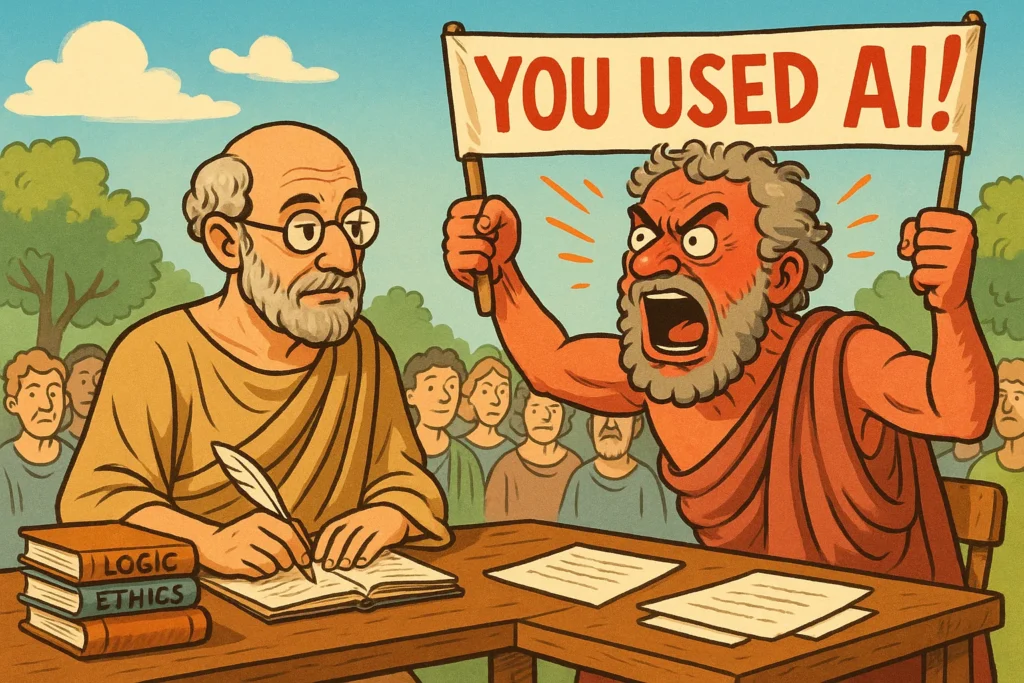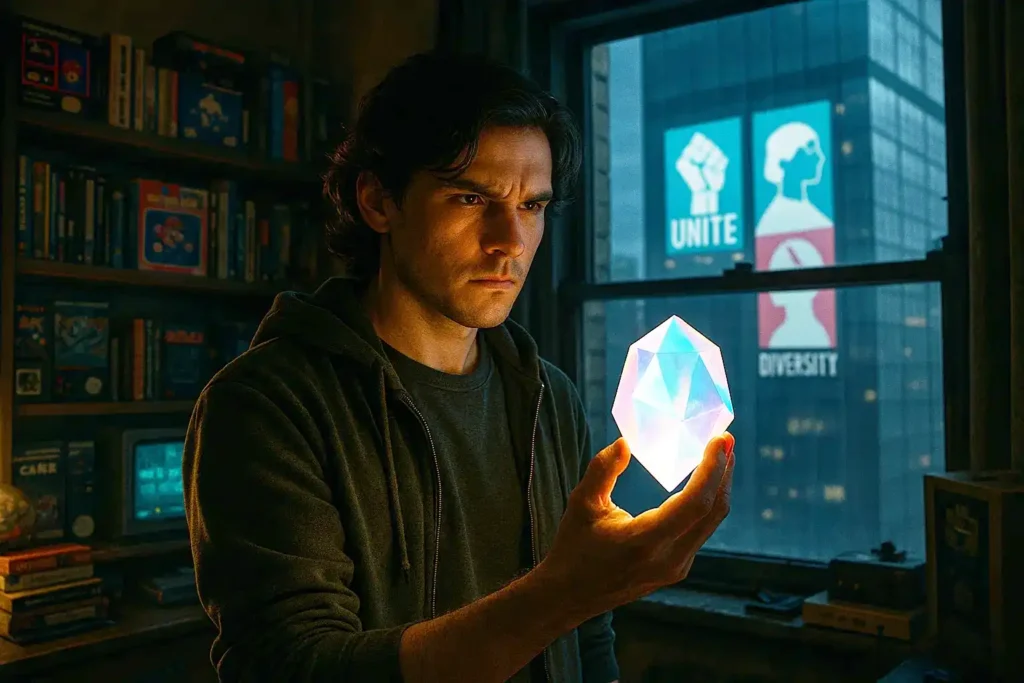Once, charges of heresy involved questions of God, man, and eternity. Today, the accusation is far more petty, yet delivered with the same self-righteous fury: “You used AI.”
This is tool shaming, the new heresy trial of the digital age. It is not a substantive critique but a lazy, bad-faith ad hominem designed to shame, dismiss, and invalidate. Its message is clear: your argument is null, your creativity is counterfeit, and your moral standing is compromised. It is the last refuge of a mind that has lost the argument—and it poisons discourse.
A Timeless Panic, A Modern Mask
Tool shaming is not new. It is the latest incarnation of a timeless panic. Socrates feared the written word would “create forgetfulness in the learners’ souls.” The Church feared the printing press would unleash heresy. The Luddites smashed looms. Critics dismissed photography, digital art, and synthesizers as “not real art.” In every case, the alarmists attacked the tool to avoid engaging with the output or the user. The current moral panic over AI is just the 21st-century version of this tired playbook—the reaction of guilds feeling the unsettling winds of democratization.

The Logic of a Hollow Man
Tool shaming is a classic ad hominem circumstantial fallacy. It attacks the circumstances of an argument’s creation rather than the argument itself. The underlying logic is childish: Your point was made with a tool I disapprove of, therefore your point is wrong.
An argument stands or falls on its own merits. Is it logical? Are its premises sound? Is it supported by evidence? The method of its drafting is irrelevant. A brilliant point does not become stupid because it was formulated with a spell checker, a research database, or a large language model. A bad argument is not sanctified because it was handwritten on vellum.
This charge is a crutch for those who cannot rebut substance. Faced with a well-reasoned, eloquent challenge, they bypass refutation to launch a superficial inquisition into the author’s process. It is the tactic of the overwhelmed and the intellectually insecure.
The “Slop” Hypocrisy
Tool shaming has birthed another meaningless term: “AI slop.” Yes, AI generates a vast amount of low-effort, generic garbage. But so do humans. The internet is a sewer of human-generated listicles, content-farm articles, and derivative asset-flip games. We don’t dismiss all human creation as “human slop.” If we did, Marvel’s endless reboots and BuzzFeed’s top-ten lists would be condemned as proof that pens themselves are corrupt tools. We judge the work on its quality.

“Slop” is a quality of the output, not the input. True critics must have the discernment to tell the difference. A skilled writer using AI as a collaborator can produce work of superior clarity. An artist using it as a dynamic sketchbook can create stunning originality. To dismiss it all as “slop” is to admit your own inability to judge quality, resorting instead to tribal signaling.
The Indie Dev’s Stone: Slaying the Woke Goliath
The most potent illustration of this hypocrisy is playing out in the video game art community, where the tool-shaming of AI is fiercest. For them, it is a heresy. For me, and for countless other indie developers, it is a godsend. This is not an abstract debate about artistic process; it is a concrete battle for the soul and survival of our craft. We are up against ESG-fueled corporate behemoths—publishing houses and studios that are bloated with capital but bankrupt of vision, more concerned with checking Diversity, Equity, and Inclusion boxes than with creating great, compelling games. They have tilted the playing field with vast resources and ideological capture.
AI is the river stone that helps us level it. It is the force multiplier that allows a small, dedicated team—passionate about timeless themes of honor, struggle, and beauty—to compete on a visual and auditory level that was previously the exclusive domain of studios with nine-figure budgets. The shamers fixate on the origin of a texture or a concept piece, not its final quality, functionality, or fit within a game’s world. This is a luxury of stance they can afford. We cannot. For us, these tools provide a fighting chance to create and disseminate works that stand against the tide of mediocrity and messaging.

The initial, clumsy use of AI is wielded as a blanket condemnation, a convenient cudgel to protect a captured status quo. But as the technology produces assets of undeniable Hollywood quality, the stigma is being revealed for what it is: a rear-guard action against a democratization of creativity they cannot control. This isn’t just about tools; it’s about who gets to define culture.
A Failure of Nerve in Dissident Circles
For those in dissident, Catholic, and traditionalist circles, tool shaming is a profound failure. Our entire project is supposedly built on logos—reason, argument, and a commitment to truth over feelings.
Yet, when challenged by an argument facilitated by a new tool, many retreat into a reactionary emotivism:
“I feel like this is cheating, therefore it is invalid.”
This is the very subjective, anti-intellectual impulse we claim to oppose.
Catholic teaching distinguishes between the usus (use) and abusus (abuse) of a thing. To condemn the usus entirely is not traditionalism; it is a Manichaean error that rejects the potential good in creation. If your critique amounts to little more than “ick, new tool,” then you’ve abandoned logos and embraced the sentimentality you claim to fight.
Conclusion: Conquer, Don’t Cower
The path forward requires intellectual courage:
- Ignore the Process, Engage the Product. Your first question must always be: “Is this true? Is this beautiful? Is this good?” Where it came from is a secondary concern.
- Demand Substance, Not Smears. When someone attempts to tool-shame you, refuse to be defensive. Force the conversation back to substance: “That’s irrelevant. If you have a critique of my argument, state it. Otherwise, you concede you have no rebuttal.”
- Conquer New Tools, Don’t Cower From Them. The future belongs to those who wield new technologies with wisdom and skill. The goal is not to reject the tool but to set a higher standard for what excellence looks like when using it.
The goal of discourse is truth and beauty, not the preservation of a guild. Tool shaming is not a mark of intellectual superiority. It is the white flag of a mind that has nothing left to offer but a sneer.
Let’s not be those people. Let’s be the ones who judge the fruit, not the root. Mastery, not fear, will decide who shapes the future—and who is left behind.
—Wolfshead





Excellent examples, Socrates and looms. There are many companies that use AI to create minor assets already from an existing pool of design elements, it turned out that an artist made wallpaper was declared to be “AI slop” while an AI generated fancy looking action-scene was declared to be “human artist made art no AI can match”. So much about that.
I have sympathy that many fear for their work and income. The loom indeed destroyed work places. But you already mentioned it. AI also allows people with a clever game idea and vision to bring it to life with good, competitive graphics that they could not afford otherwise. Many cool games were made by just 1-2 or 3 man teams. This seems no longer possible these days with a supposed need for dedicated sound ,graphics, UI etc. etc. designers.
There will still be masters of their craft in future and many also very talented people. But AI will likely totally eliminate the lower echelons. And who knows, maybe reach unknown heights of approval and mastery by itself.
I already mentioned it in a previous comment in another article, the supposed “need” to voice every NPC nowadays, if that is really necessary (I don’t think so, personally), AI is perhaps the only economically viable solution for that.
Maybe it will also do wonders for EQ if fans manage to get the IP out of the hands of EG7 one day. One can always dream.
AI in all its incarnations will vastly reduce the cost of making video games. The major studios all have to be woke thanks to ESG compliance and they will be going out of business. Not only that, all the woke artists and creatives that had to hire to make their ESG numbers will no longer have featherbed jobs in the industry, the same with Hollywood.
We are truly at the dawn of a new age of creativity which will allow dissident voices like myself to make video games based on tried and true concepts of gameplay and challenge.